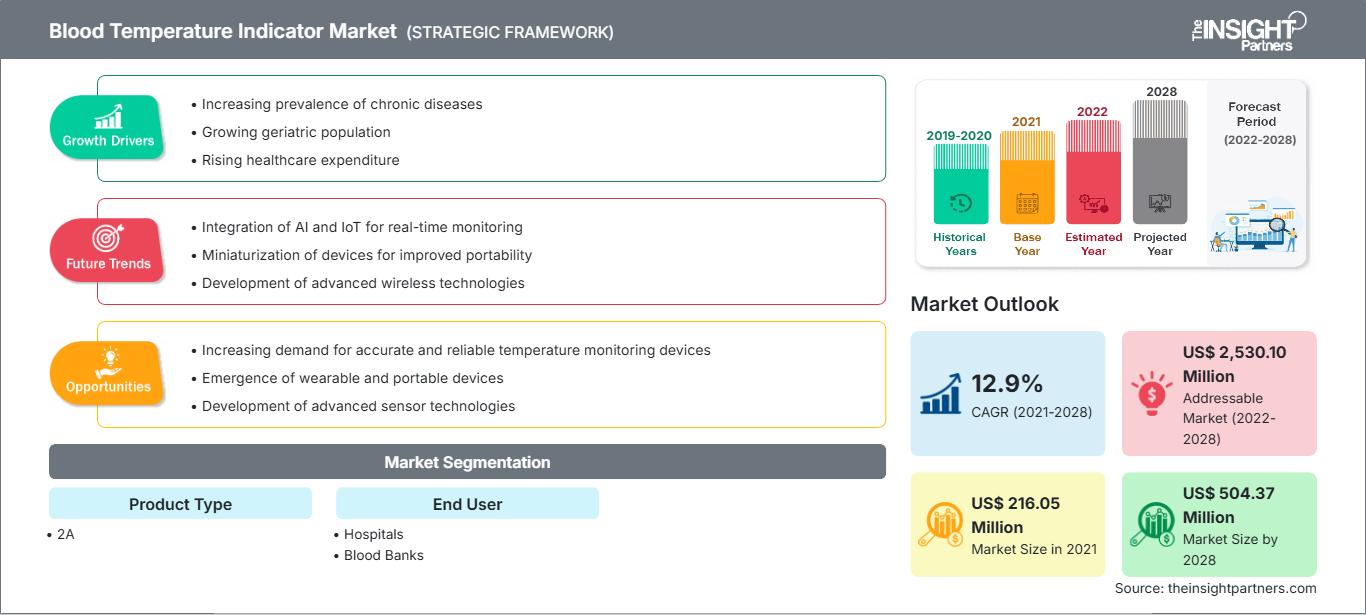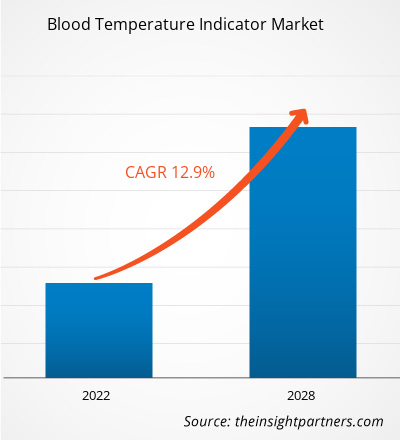Si prevede che il mercato degli indicatori di temperatura sanguigna crescerà da 216,05 milioni di dollari nel 2021 a 504,37 milioni di dollari entro il 2028; si stima che registrerà un CAGR del 12,9% dal 2021 al 2028.
Gli indicatori di temperatura sanguigna sono piccoli dispositivi o soluzioni mediche che contribuiscono ad aumentare la sicurezza del sangue trasportando in modo efficace ed efficiente il sangue e i suoi componenti. Questi indicatori forniscono una prova verificabile che il sangue viene conservato e trasportato secondo gli standard normativi, riducendo ulteriormente lo spreco di sangue.
Il rapporto fornisce approfondimenti e analisi approfondite del mercato degli indicatori di temperatura sanguigna, evidenziando vari parametri come tendenze di mercato, progressi tecnologici e dinamiche di mercato. Fornisce inoltre un'analisi del panorama competitivo dei principali attori del mercato e l'impatto della pandemia di COVID-19 sul mercato degli indicatori di temperatura sanguigna in tutte le principali regioni. La pandemia di COVID-19 ha sconvolto le condizioni socioeconomiche di diversi paesi in tutto il mondo. Secondo le statistiche dell'OMS del 2021, gli Stati Uniti sono il Paese più colpito al mondo dalla pandemia di COVID-19, con il numero più alto di casi di COVID-19. L'elevato numero di casi ha ostacolato l'economia del Nord America, in particolare degli Stati Uniti. La pandemia di COVID-19 ha portato a cambiamenti tecnologici critici per fornire una migliore assistenza medica. A causa della diffusione del SARS-CoV-2, molte città sono state chiuse, con conseguente annullamento dei trattamenti da parte di medici e chirurghi. La pandemia di COVID-19 ha influenzato la produzione e la fornitura di indicatori della temperatura sanguigna a causa dell'interruzione della catena di approvvigionamento a livello globale. Inoltre, gli operatori sanitari stanno dando priorità alle procedure di emergenza e hanno annullato tutti gli interventi chirurgici elettivi per prevenire la diffusione del coronavirus.
Nel 2020, la Food and Drug Administration (FDA) ha autorizzato l'uso di plasma convalescente in caso di emergenza per il trattamento dei pazienti affetti da COVID-19, con conseguente aumento delle donazioni di sangue. Inoltre, si prevede che la presenza di importanti attori del mercato e le loro varie collaborazioni strategiche nel mercato degli indicatori della temperatura sanguigna sosterranno la crescita del mercato. Ad esempio, Timestrip, lo sviluppatore della tecnologia degli indicatori intelligenti, sta lanciando una gamma completamente nuova con due indicatori elettronici di temperatura. Questi indicatori saranno fondamentali per monitorare la conservazione e il trasporto sicuri di vari beni, tra cui prodotti farmaceutici, vaccini, prodotti sanitari, prodotti alimentari, adesivi e inchiostri. Pertanto, la pandemia di COVID-19 ha avuto un impatto negativo sul mercato degli indicatori della temperatura sanguigna.
In base alla regione, il mercato degli indicatori della temperatura sanguigna è segmentato in Nord America, Europa, Asia-Pacifico, Medio Oriente e Africa e Sud e Centro America.
Personalizza questo rapporto in base alle tue esigenze
Potrai personalizzare gratuitamente qualsiasi rapporto, comprese parti di questo rapporto, o analisi a livello di paese, pacchetto dati Excel, oltre a usufruire di grandi offerte e sconti per start-up e università
Mercato degli indicatori della temperatura del sangue: Approfondimenti strategici

-
Ottieni le principali tendenze chiave del mercato di questo rapporto.Questo campione GRATUITO includerà l'analisi dei dati, che vanno dalle tendenze di mercato alle stime e alle previsioni.
Approfondimenti di mercato
L'aumento delle trasfusioni e delle donazioni di sangue stimola il mercato degli indicatori di temperatura sanguigna
La trasfusione di sangue è una delle procedure più comunemente utilizzate in ambito sanitario, che aiuta a mantenere costante il livello di globuli rossi nei pazienti. Esistono diverse patologie croniche, interventi chirurgici e traumi che richiedono trasfusioni di sangue affinché i pazienti possano sopravvivere senza effetti collaterali dovuti a bassi livelli di globuli rossi nel sangue. Patologie come talassemia, tumori del sangue, anemia falciforme, anemia e interventi chirurgici e traumi causano perdite di sangue e richiedono una trasfusione. Secondo la Croce Rossa Americana, negli Stati Uniti vengono trasfusi circa 16 milioni di emocomponenti ogni anno. Inoltre, l'anemia falciforme colpisce tra 90.000 e 100.000 persone negli Stati Uniti; circa 1.000 bambini nascono con questa malattia ogni anno. Pertanto, la crescente prevalenza di malattie croniche ha creato una domanda di trasfusioni di sangue, che si prevede favorirà la crescita del mercato degli indicatori di temperatura del sangue.
Dopo il prelievo, il sangue deve essere conservato e trasportato in condizioni e temperature specifiche. Se il sangue viene conservato e trasportato al di fuori dell'intervallo di temperatura specificato per un periodo prolungato, perde la sua capacità di trasportare ossigeno, il che può causare gravi problemi. Inoltre, esiste il rischio di grave contaminazione batterica se il sangue viene esposto a temperature elevate. Gli indicatori di temperatura del sangue svolgono un ruolo importante nel mantenere le condizioni e la temperatura necessarie per un trasporto sicuro e affidabile del sangue e dei suoi componenti. Riducono il rischio di deterioramento del sangue monitorando attentamente la temperatura e mantenendo il sangue al sicuro durante il trasporto. Pertanto, l'aumento delle trasfusioni di sangue, delle donazioni di sangue e la crescente domanda di trasporto sicuro del sangue e dei suoi componenti creano una domanda di indicatori di temperatura del sangue, che guida la crescita del mercato.
Approfondimenti basati sulla tipologia di prodotto
In base alla tipologia di prodotto, il mercato degli indicatori di temperatura del sangue è segmentato in 2°C-4°C, 5°C-7°C e oltre 7°C. Nel 2021, il segmento 2°C-4°C ha rappresentato la quota di mercato maggiore. La posizione di mercato di questo segmento è aumentata grazie al suo utilizzo principale durante il trasporto di sangue su lunghe distanze. Ad esempio, secondo le principali linee guida europee e americane, la temperatura delle sacche di globuli rossi deve variare da 1°C a 6°C durante la conservazione e da 1°C a 10°C durante il trasporto.
Mercato degli indicatori della temperatura del sangueLe tendenze regionali e i fattori che influenzano il mercato degli indicatori di temperatura sanguigna durante il periodo di previsione sono stati ampiamente spiegati dagli analisti di The Insight Partners. Questa sezione illustra anche i segmenti e la distribuzione geografica del mercato degli indicatori di temperatura sanguigna in Nord America, Europa, Asia-Pacifico, Medio Oriente e Africa, America meridionale e centrale.
Ambito del rapporto di mercato sugli indicatori della temperatura del sangue>
| Attributo del rapporto | Dettagli |
|---|---|
| Dimensioni del mercato in 2021 | US$ 216.05 Million |
| Dimensioni del mercato per 2028 | US$ 504.37 Million |
| CAGR globale (2021 - 2028) | 12.9% |
| Dati storici | 2019-2020 |
| Periodo di previsione | 2022-2028 |
| Segmenti coperti |
By Tipo di prodotto
|
| Regioni e paesi coperti |
Nord America
|
| Leader di mercato e profili aziendali chiave |
|
Densità degli operatori del mercato degli indicatori della temperatura del sangue: comprendere il suo impatto sulle dinamiche aziendali
Il mercato degli indicatori della temperatura sanguigna è in rapida crescita, trainato dalla crescente domanda degli utenti finali, dovuta a fattori quali l'evoluzione delle preferenze dei consumatori, i progressi tecnologici e una maggiore consapevolezza dei benefici del prodotto. Con l'aumento della domanda, le aziende stanno ampliando la propria offerta, innovando per soddisfare le esigenze dei consumatori e sfruttando le tendenze emergenti, alimentando ulteriormente la crescita del mercato.

- Ottieni il Mercato degli indicatori della temperatura del sangue Panoramica dei principali attori chiave
Informazioni per l'utente finale
In base all'utente finale, il mercato degli indicatori della temperatura del sangue è segmentato in ospedali, banche del sangue e altri. Il segmento ospedaliero ha dominato il mercato nel 2021.
Gli operatori del mercato degli indicatori della temperatura sanguigna adottano strategie organiche come il lancio e l'espansione dei prodotti per espandere la propria presenza e il portafoglio prodotti a livello globale.
Profili aziendali
- Elitech
- Thero Fisher Scientific Inc.
- Sercalia
- Ellab Group
- Zebra Technologies Corporation
- Lisaline Lifesceinces Technologies
- Stream Peak International PTE Ltd
- 3M
- DeltaTrak Inc.
- TimeStrip UK Ltd
- Analisi storica (2 anni), anno base, previsione (7 anni) con CAGR
- Analisi PEST e SWOT
- Valore/volume delle dimensioni del mercato - Globale, Regionale, Nazionale
- Industria e panorama competitivo
- Set di dati Excel
Report recenti
Rapporti correlati
Testimonianze
Motivo dell'acquisto
- Processo decisionale informato
- Comprensione delle dinamiche di mercato
- Analisi competitiva
- Analisi dei clienti
- Previsioni di mercato
- Mitigazione del rischio
- Pianificazione strategica
- Giustificazione degli investimenti
- Identificazione dei mercati emergenti
- Miglioramento delle strategie di marketing
- Aumento dell'efficienza operativa
- Allineamento alle tendenze normative






















 Ottieni un campione gratuito per - Mercato degli indicatori della temperatura del sangue
Ottieni un campione gratuito per - Mercato degli indicatori della temperatura del sangue